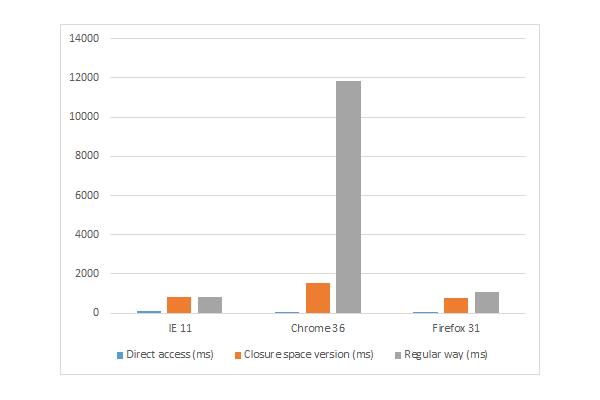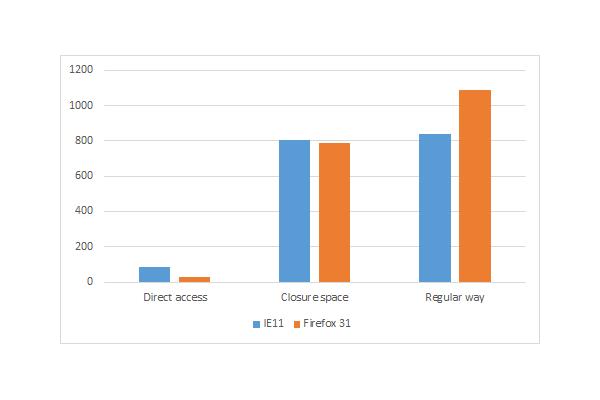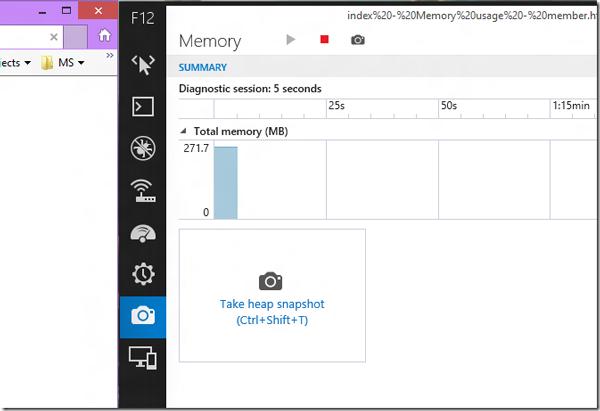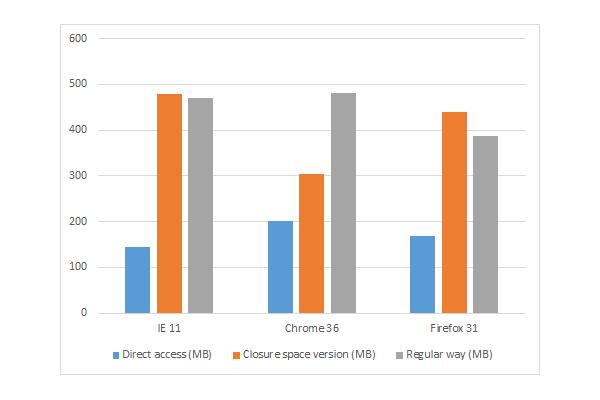社区微信群开通啦,扫一扫抢先加入社区官方微信群

社区微信群
社区微信群开通啦,扫一扫抢先加入社区官方微信群

社区微信群
最近,我开发一个项目 Angular Cloud Data Connector, 帮助Angular开发者使用云数据,特别是 Azure移动服务, 使用WEB标准,像索引数据库(indexed DB)。我尝试建立一种方式,使得JavaScript开发者能将私有成员嵌入到一个对象中。
我解决这个问题的技术用到了我命名的闭包空间(closure space)。在这篇入门文章中,我要分享的是如何在你的项目中用它,及它对主流浏览器的性能和内存的影响。
在深入学习前,咱们先说下,你为什么需要用到私有成员(private members), 还有一种替代方式来模拟私有成员。
如果你想点评本文,尽情推(twitter)我: @deltakosh。
1. 为何要用私有成员(Private Members)
当你用JavaScript 创建一个对象时,可以声明值成员(value members)。 如果你打算控制对它们的读/写访问操作,可以如下声明:
- var entity = {};
- entity._property = "hello world";
- Object.defineProperty(entity, "property", {
- get: function () { return this._property; },
- set: function (value) {
- this._property = value;
- },
- enumerable: true,
- configurable: true
- });
这样实现,你能完全控制读和写操作。问题在于_property 成员仍然可以直接访问和修改。
这也就是为何我们需要更加稳定可靠的方式,声明私有成员,它智能通过对象的方法来访问。
2. 使用闭包空间(Closure Space)
解决方法是使用闭包空间。每当内部函数 (inner fanction) 访问来自外部函数作用域的变量时,浏览器为你分配一段内存空间。有时很取巧,不过就我们的题目来讲,这算是一个***的解决方案。
我们在上个代码版本中添加这个特性:
- var createProperty = function (obj, prop, currentValue)
- {
- Object.defineProperty(obj, prop,
- {
- get: function () { return currentValue; },
- set: function (value) {
- currentValue = value;
- },
- enumerable: true,
- configurable: true });
- }
- var entity = {};
- var myVar = "hello world";createProperty(entity, "property", myVar);
示例中,createProperty 函数有一个 currentValue 变量,存在 get 和 set 方法。此变量会保存到 get 和 set 函数的闭包空间中。现在,只有这两个函数能看到和更新 currentValue 变量! 任务完成!
唯一需要警惕 caveat,警告,注意)的是源值 (myVar) 仍可访问。下面给出另一个更健壮的版本(保护 myVar 变量):
- var createProperty = function (obj, prop) {
- var currentValue = obj[prop];
- Object.defineProperty(obj, prop, {
- get: function () { return currentValue; },
- set: function (value) {
- currentValue = value;
- },
- enumerable: true,
- configurable: true
- });
- }
- var entity = {
- property: "hello world"
- };
- createProperty(entity, "property");
采用该函数, 即便源值都销毁(destructed,注:意思是不能直接赋值)了。到此大功告成了!
3. 性能考虑Performance Considerations
现在咱们看看性能。
很明显,比起一个简单的变量,闭包空间,甚或(对象)属性要慢的多,且更消耗资源。这就是本文更多关注普通方式和闭包空间机制差异的原因。
为证明闭包空间机制并不比标准方式更消耗资源, 我写了下面代码做个基准测试:
- <!DOCTYPE html>
- <html xmlns="http://www.w3.org/1999/xhtml">
- <head>
- <title></title>
- </head>
- <style>
- html {
- font-family: "Helvetica Neue", Helvetica;
- }
- </style>
- <body>
- <div id="results">Computing...</div>
- <script>
- var results = document.getElementById("results");
- var sampleSize = 1000000;
- var opCounts = 1000000;
- var entities = [];
- setTimeout(function () {
- // Creating entities
- for (var index = 0; index < sampleSize; index++) {
- entities.push({
- property: "hello world (" + index + ")"
- });
- }
- // Random reads
- var start = new Date().getTime();
- for (index = 0; index < opCounts; index++) {
- var position = Math.floor(Math.random() * entities.length);
- var temp = entities[position].property;
- }
- var end = new Date().getTime();
- results.innerHTML = "<strong>Results:</strong><br>Using member access: <strong>" + (end - start) + "</strong> ms";
- }, 0);
- setTimeout(function () {
- // Closure space =======================================
- var createProperty = function (obj, prop, currentValue) {
- Object.defineProperty(obj, prop, {
- get: function () { return currentValue; },
- set: function (value) {
- currentValue = value;
- },
- enumerable: true,
- configurable: true
- });
- }
- // Adding property and using closure space to save private value
- for (var index = 0; index < sampleSize; index++) {
- var entity = entities[index];
- var currentValue = entity.property;
- createProperty(entity, "property", currentValue);
- }
- // Random reads
- var start = new Date().getTime();
- for (index = 0; index < opCounts; index++) {
- var position = Math.floor(Math.random() * entities.length);
- var temp = entities[position].property;
- }
- var end = new Date().getTime();
- results.innerHTML += "<br>Using closure space: <strong>" + (end - start) + "</strong> ms";
- }, 0);
- setTimeout(function () {
- // Using local member =======================================
- // Adding property and using local member to save private value
- for (var index = 0; index < sampleSize; index++) {
- var entity = entities[index];
- entity._property = entity.property;
- Object.defineProperty(entity, "property", {
- get: function () { return this._property; },
- set: function (value) {
- this._property = value;
- },
- enumerable: true,
- configurable: true
- });
- }
- // Random reads
- var start = new Date().getTime();
- for (index = 0; index < opCounts; index++) {
- var position = Math.floor(Math.random() * entities.length);
- var temp = entities[position].property;
- }
- var end = new Date().getTime();
- results.innerHTML += "<br>Using local member: <strong>" + (end - start) + "</strong> ms";
- }, 0);
- </script>
- </body>
- </html>
我创建了一百万个对象,都有属性成员。要完成下面三个测试:
执行 1百万次随机访问属性。
执行1百万次随机访问闭包空间实现版本。
执行1百万次随机访问常规get/set实现版本。
测试结果参见下面表格和图表:


我们发现,闭包空间实现总是快于常规实现,根据浏览器的不同,还可以做进一步的性能优化。
Chrome 上的性能表现低于预期。或许存在 bug,因此,为确认(存在 bug),我联系了 Google 项目组,描述发生的症状。还有,如果你打算测试在 Microsoft Edge —微软新发布的浏览器,在windows10 中默认安装—中的性能表现,你可以点击下载 。
然而,如果仔细研究,你会发现,使用闭包空间或属性比直接访问变量成员要10倍左右。 因此,使用要恰当且谨慎。

4. 内存占用(Memory Footprint)
我们也得验证该技术不会消耗过多内存。为测试内存占用基准情况,我写了下面代码段:
直接属性引用版本(Reference Code)
- var sampleSize = 1000000;
- var entities = [];
- // Creating entities
- for (var index = 0; index < sampleSize; index++) {
- entities.push({
- property: "hello world (" + index + ")"
- });}
- 常规方式版本(Regular Way,get/set)
- var sampleSize = 1000000;
- var entities = [];
- // Adding property and using local member to save private value
- for (var index = 0; index < sampleSize; index++) {
- var entity = {};
- entity._property = "hello world (" + index + ")";
- Object.defineProperty(entity, "property", {
- get: function () { return this._property; },
- set: function (value) {
- this._property = value;
- },
- enumerable: true,
- configurable: true
- });
- entities.push(entity);
- }
- 闭包空间版本(Closure Space Version)
- var sampleSize = 1000000;
- var entities = [];
- var createProperty = function (obj, prop, currentValue) {
- Object.defineProperty(obj, prop, {
- get: function () { return currentValue; },
- set: function (value) {
- currentValue = value;
- },
- enumerable: true,
- configurable: true
- });
- }
- // Adding property and using closure space to save private value
- for (var index = 0; index < sampleSize; index++) {
- var entity = {};
- var currentValue = "hello world (" + index + ")";
- createProperty(entity, "property", currentValue);
- entities.push(entity);
- }
之后,我(在三个主流浏览器上)运行所有的三段代码,启动(浏览器)内嵌的内存性能分析器(本示例中使用 F12 工具条):

我计算机上运行的结果如下图表:

就闭包空间和常规方式,只有 Chrome上,闭包空间(内存占用)表现稍好,在 IE11 和 Firefox上占用内存反而增多,但是浏览器的比较结果e—对于现代浏览器,用户很可能不会在意这点差别。
更多 JavaScript 实践
或许你会吃惊,微软提供了一批有关开源 Javascript 主题的免费学习材料, 我们正在发起一个任务,关于创建更多 Microsoft Edge 来临 系列。 查看我的文章:
基于 HTML5 和 Babylon.JS 开发 WebGL 3D 基础
或者我们团队系列:
HTML/JavaScript 性能优化使用技巧 (该系列有7部分,从响应式设计到休闲游戏的性能优化)
现代 Web 平台快速起步 ( HTML, CSS, and JS基础)
开发通用的 Windows Apps,使用 HTML 和 JavaScript 快速起步 (使用你自己的JS构建app)
以及一些免费工具:Visual Studio 社区,Azure 试用版和跨浏览器测试工具用于 Mac, Linux, 或者 Windows。
结论(Conclusion)
如你所见,对于创建真正的私有数据来讲,闭包空间属性(机制)是一个很棒的做法。或许你得面对内存消耗小幅度增加(问题),但就我的看法,这却很合理 (这个代价可以换取相对于常规方法更高的性能增长)。
随带说一句, 如果你要自己动手试试,所以代码可以在 here下载。 推荐一篇不错的文章, “how-to” on Azure Mobile Services here。
如果觉得我的文章对您有用,请随意打赏。你的支持将鼓励我继续创作!
